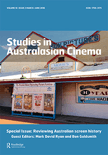
Studies in Australasian Cinema
Scope & Guideline
Exploring the Depths of Australasian Film
Introduction
Aims and Scopes
- Cultural Representation and Identity:
The journal explores how film serves as a medium for cultural representation, particularly focusing on Indigenous perspectives, ethnic diversity, and the portrayal of gender and sexuality in Australasian cinema. - Historical Analysis of Cinema:
It delves into the historical development of Australian and New Zealand cinema, examining genres, production practices, and significant movements that have shaped the film industry. - Innovative Filmmaking Practices:
The journal highlights innovative approaches to filmmaking, including hybrid documentary forms, collaborative practices between academia and industry, and the role of emerging technologies. - Critical Theory and Film Studies:
It engages with critical theories relevant to film studies, applying frameworks from feminist theory, post-colonial studies, and queer theory to analyze cinematic texts and practices. - Educational Practices in Film:
The journal addresses educational methodologies related to film studies and production, investigating how film schools and educational institutions contribute to the creative landscape.
Trending and Emerging
- Disruptive and Hybrid Narratives:
There is a growing focus on disruptive narrative forms, particularly in documentaries and experimental films. This trend reflects a broader interest in challenging traditional storytelling techniques and exploring new ways of narrative construction. - Intersectionality in Film:
Recent publications increasingly emphasize intersectional approaches, examining how race, gender, sexuality, and class intersect within the cinematic context, thus highlighting diverse voices and experiences. - Environmental and Social Themes:
Emerging themes related to environmentalism and social justice are becoming more prominent, with filmmakers using cinema to address pressing global issues, such as climate change and social inequities. - Queer Cinema and Representation:
The journal has seen a rise in discussions around queer cinema, focusing on representation, identity, and the contributions of LGBTQ+ filmmakers within the Australasian context. - Collaborative Filmmaking Practices:
There is a notable trend towards exploring collaborative practices in filmmaking, particularly between academic institutions and the film industry, which reflects an interest in co-creating knowledge and fostering innovation.
Declining or Waning
- Traditional Genre Analysis:
There seems to be a waning interest in conventional genre studies, particularly those that do not intersect with contemporary issues of identity or cultural representation. The focus has shifted towards more innovative and hybrid forms of storytelling. - Mainstream Film Critique:
Critiques of mainstream cinema, especially those that do not engage with issues of socio-cultural impact, have decreased. The journal's current trajectory favors analyses that link cinema to broader cultural and political contexts. - Historical Documentations of the Film Industry:
While historical analysis remains relevant, there is a noticeable decline in papers solely focused on the historical documentation of the film industry without a contemporary lens, as the journal emphasizes present-day implications and narratives.
Similar Journals
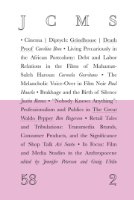
JCMS-Journal of Cinema and Media Studies
Advancing Scholarly Dialogue in Media StudiesJCMS-Journal of Cinema and Media Studies, published by University of Texas Press, stands as a vital platform for scholars and practitioners in the realms of cinema, media, and visual arts. With an ISSN of 2578-4900 and an E-ISSN of 2578-4919, the journal has been a part of the academic landscape since its inception in 2018 and will continue to contribute valuable research until 2024. Notably ranked in the top tiers of Scopus, securing Q1 status in Visual Arts and Performing Arts and Q3 in Communication, JCMS features articles that critically engage with both traditional and contemporary issues in media studies. Located in the United States, the journal is committed to providing open access to a wide array of interdisciplinary research, fostering dialogue among researchers, students, and media professionals. By serving as a nexus for innovative scholarship and creative discourse, JCMS enriches our understanding of cinematic and media practices and their impact on society today.

POSITIF
Connecting Researchers and Practitioners in Arts InnovationPOSITIF is a distinguished journal, published by POSITIF EDITIONS, focusing on the dynamic fields of Visual Arts and Performing Arts. With ISSN 0048-4911, this journal has been a significant contributor to the arts community since its establishment in 2002, and it continues to captivate readers with its upcoming issues projected until 2024. Based in the heart of France at 12 RUE PIERRE ET MARIE CURIE, 75005 PARIS, POSITIF serves as an invaluable platform for researchers, professionals, and students alike, promoting innovative discourse and critical analysis within the arts. Despite holding a Q4 category ranking in the 2023 classification and a Scopus rank of 637/667, its commitment to enhancing the understanding and appreciation of visual and performing arts remains steadfast. Researchers are invited to contribute to this growing body of knowledge, enriching the journal's scope and impact in a vibrant artistic landscape.
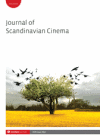
Journal of Scandinavian Cinema
Celebrating the Rich Tapestry of Scandinavian CinemaThe Journal of Scandinavian Cinema, established in 2014 and published by INTELLECT LTD, serves as a premier platform dedicated to the interdisciplinary field of film studies with a specific focus on Scandinavian cinema. With an impressive Q2 category ranking in Visual Arts and Performing Arts for 2023, and a Scopus rank placing it in the top 62nd percentile of its category, this journal is instrumental in advancing scholarly dialogue within the arts community. The journal strives to explore and critique cinematic expressions from the Nordic countries, contributing to a nuanced understanding of cultural narratives and filmic innovations. Committed to fostering accessibility and engagement, it caters to a diverse audience including researchers, professionals, and students keen to delve into the artistic, cultural, and political dimensions of cinema. The Journal of Scandinavian Cinema is essential for anyone interested in the evolution and impact of film in the Scandinavian context, promising rich insights and a robust collection of scholarly articles.
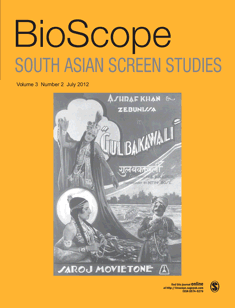
Bioscope-South Asian Screen Studies
Illuminating the Rich Tapestry of South Asian CinemaBioscope-South Asian Screen Studies is an influential journal dedicated to advancing the field of screen studies in the South Asian context, published by SAGE Publications India Pvt Ltd. With an ISSN of 0974-9276 and an E-ISSN of 0976-352X, this journal spans a convergence of scholarly research from 2010 to 2024, providing a significant platform for interdisciplinary dialogue. Holding a Q3 rating in Communication and a Q2 rating in Visual Arts and Performing Arts in the 2023 category quartiles, it ranks 212th in its field on Scopus, reflecting its vital contribution to academic discourse. Bioscope aims to explore and critically analyze the rich tapestry of South Asian cinema, media, and performance arts, offering researchers, professionals, and students a valuable resource for deepening their understanding of regional and global cinematic narratives. Readers will find insightful articles that probe the cultural, social, and political dimensions of screen studies, making this journal an essential reference for anyone engaged in the evolving landscape of South Asian visual culture.

Film-Philosophy
Bridging Film Studies and Philosophical InquiryFilm-Philosophy is an esteemed academic journal published by Edinburgh University Press, specializing in the intersection of film studies and philosophical discourse. Since its launch in 1998, this Open Access journal has provided a platform for scholarly debates and innovative research, allowing for free and unrestricted access to its content, which has significantly contributed to the global dialogue on visual culture. With a commendable impact illustrated by its Q1 ranking in Visual Arts and Performing Arts and Q2 in Philosophy, the journal sits within the top quartile of its field. Operating from the United Kingdom, Film-Philosophy is committed to fostering a multidisciplinary approach, inviting contributions from researchers, professionals, and students alike. By engaging with critical theories and the aesthetics of cinema, the journal stands as a vital resource for understanding the philosophical implications of film and its cultural significance.

Cinema-Journal of Philosophy and the Moving Image
Illuminating Cinema through Philosophical Inquiry.Cinema: Journal of Philosophy and the Moving Image is a distinguished open-access journal dedicated to the critical analysis of cinema through the lenses of philosophy and cultural theory. Published by the esteemed New University of Lisbon's IFILNOVA - Nova Philosophy Institute, this journal has been a crucial platform for the dissemination of innovative and interdisciplinary research since its establishment in 2010. With an ISSN of 1647-8991 and a significant presence in both Communication and Visual Arts categories, it currently holds a Q4 ranking in 2023, reflecting its growing role in the academic discourse of its field. While the journal has a modest impact as indicated by its Scopus rankings, it serves as a vital resource for researchers, professionals, and students interested in the intersection of philosophy and the moving image, fostering rich dialogues about cinema's impact on society and culture. Situated in Portugal, Cinema invites submissions that challenge conventional perceptions, engaging with both contemporary and historical contexts of film and imagery, thereby playing an essential role in expanding the horizons of film studies.

Hrvatski Filmski Ljetopis
Analyzing the Rich Tapestry of Croatian Cinema.Hrvatski Filmski Ljetopis, published by the Croatian Film Clubs Association, serves as a pivotal academic journal in the field of film studies, celebrating and analyzing the rich cinematic heritage of Croatia and beyond. With an ISSN of 1330-7665, this journal caters to researchers, practitioners, and students who are passionate about the art of filmmaking, encompassing both theoretical discourse and practical implications. Although it is not currently available as an open-access publication, its curated content is of significant value to anyone interested in the evolution, critique, and history of film in a Croatian context, having previously been indexed in Scopus until coverage was discontinued. The journal operates out of Zagreb, Croatia, at the Croatian Film Clubs Association headquarters, and aims to foster scholarly dialogue while contributing to the broader field of national and international cinematography.

CINEASTE
Cultivating a Deeper Appreciation for CinemaCINEASTE is a distinguished journal dedicated to the critical exploration of cinema, providing a platform for scholars, filmmakers, and enthusiasts to engage with the complexities of film studies. Established and published by CINEASTE, this periodical serves as a vital resource for those interested in the intersection of visual arts and performing arts. Although it is not currently offered as Open Access, CINEASTE remains a respected publication within the academic community, having been indexed in Scopus until 2016. With an ISSN of 0009-7004, it has established itself despite its lower ranking in the arts and humanities category, reflecting the competitive nature of this field. Researchers, students, and professionals alike will find ample opportunities for insightful discussion and scholarly contributions to the evolving landscape of cinematic discourse. CINEASTE continues to uphold its mission of enhancing film scholarship, making it a crucial reference point for anyone eager to deepen their understanding of cinema's artistic and cultural significance.

Journal of British Cinema and Television
Engaging with the Pulse of British Visual CultureJournal of British Cinema and Television, published by Edinburgh University Press, is a leading academic journal that explores the dynamic interplay between British cinema and television within the context of cultural studies. With an ISSN of 1743-4521 and E-ISSN of 1755-1714, this journal provides a platform for scholarly discourse, enabling researchers, professionals, and students to engage with critical analyses of screen media and its socio-political impact. As a Q3 journal in Communication and a Q1 journal in Visual Arts and Performing Arts for 2023, it occupies an influential position, particularly in the Arts and Humanities, where it ranks in the 90th percentile. The journal's scope encompasses a wide range of topics, from historical perspectives to contemporary practices in British visual culture, making it essential reading for anyone interested in the evolution and significance of screen studies in the UK. While it is not an open-access publication, the rigorous peer-review process ensures high academic standards and contributes to its esteemed reputation in the field. As it continues to converge from 2004 to 2024, the Journal of British Cinema and Television remains a vital resource for those seeking to deepen their understanding of British media and its global resonance.
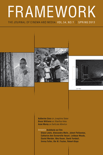
Framework-The Journal of Cinema and Media
Advancing scholarship in film and media theory.Framework: The Journal of Cinema and Media is a prominent academic journal published by Wayne State University Press, focusing on the dynamic fields of cinema studies and media theory. With an ISSN of 0306-7661 and an E-ISSN of 1559-7989, it serves as a key platform for researchers, professionals, and students to explore critical issues in media culture, film theory, and the intersection of digital technologies and narrative. Although it does not currently offer open access, the journal maintains a reputation for rigorous scholarship and thought-provoking content, providing insights that challenge conventional understandings of media and its impact on society. Published in Detroit, MI, Framework continues to engage with contemporary debates and innovative practices in cinema and media, making it an essential resource for those dedicated to advancing research in these vibrant disciplines.